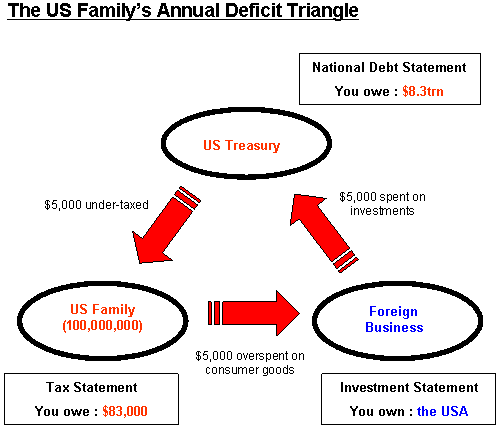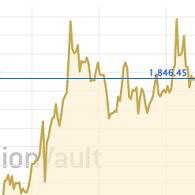The value of rarity
Understand your upside before buying gold
The Deficit Triangle
The number of zeros on formal statistics sometimes disguises their real meaning.
The US government currently borrows $5,000 a year on behalf of each US
family, which it dares not tax for electoral reasons. This is the
source of the budget deficit. That uncollected money remains in the
hands of the family, which currently prefers buying foreign goods and
spends $5,000 on them, producing the trade deficit. The foreign
supplier sends the $5,000 back to the US by buying government bonds and
American businesses. This money from abroad is the source of the
fine-sounding US capital inflow.

Give or take $1,000 this same $5,000 deficit triangle is completed for
each of about 100 million US households every year, and that is why
there is a $500 billion budget deficit, and similar trade deficit and
US capital inflow. It is tempting to assume that this is the way it has
always been and that somehow it must be stable, but that is wrong. This
is a wholly new way of arranging things.
Source of US economic growth
The last four-year administration ended having increased the average US
family's gross future tax debt by about $19,000. The family's total
accumulated uncollected tax - i.e. its share of the country's public
debt - grew by that $19,000 to about $74,000, three quarters of which
has been built up since 1985. The demand which has sustained growth for
twenty years has arisen from this money being spent twice, once by the
family, and once by the state, and this duplicated spending is the only
explanation that is needed to understand the remarkable strength of the
USA's economy. But the legacy of it was this $74,000 tax debt for each
of just over 100 million families, which just 18 months later has grown
to $83,000.
The downside of debt
How serious is an $83,000 tax debt? We don't know because it has never
happened before, but we do know that in Argentina in 2001 their
sovereign public debt was about $12,000 per family, and at that level
it triggered the capital flight which was the direct cause of their
debt default and subsequent economic crunch. It is both extraordinary
confidence in underlying USA economic robustness and an apparent lack
of alternate options which appears to be preventing a similar US
setback. But the confidence rests on the demand strength, which itself
arises from the scale of the deficit triangle.
What happens next?
To resolve the US public debt problem safely is very difficult. Raising
taxes to the required level is unthinkable - both electorally and
because it would hurt domestic spending and feed back into a
deflationary spiral of declining output and demand. Trade protectionism
was tried before and it triggered tit-for-tat export restrictions and
global depression. The only viable route out is devaluation of the
debt, which is equivalent to inflation.
Assessing how severe the coming inflation might be is also difficult,
but it is possible to get an idea by looking at the bond market. For
twenty five years the bond market has been growing fast, to about 40
times what it was in the early eighties. Through most of that time
interest rates and inflation were falling, so fixing a rate of return
with a bond was an attractive option for a saver. As a result while
borrowers were spending savers were diverting their cash out of the
economy and freezing it in bond portfolios, until eventually US dollar
bond markets have grown to contain 50 times all the dollars in current
circulation.
This frozen money is up for redemption over the coming years so it will
turn back into cash, and little of it can sensibly be re-invested in
bonds with inflation threatening and rates turning up from long cycle
lows. In any event much of it must be returned as consumable cash to
the retiring boomer generation.
This suggests a possible cash glut in the medium term, and that
indicates inflation too. Aggressive inflations do tend to follow an
accumulation of official indebtedness. It would be unusual if the
current US situation did not result in something similar.
Fear of this should have already caused a downwards dollar correction,
but this has not happened because the alternate currencies have similar
problems. The Yen is afflicted by an equally difficult sovereign debt
problem, while the Euro looks politically unstable and can agree
neither a constitution nor an ongoing budget. Commodities on the other
hand have been rising in price - and gold particularly so.
Gold's rarity
Gold is famously useless in almost everything except that it cannot be made, and is reliably difficult to find.
Even now if all the gold ever produced on Earth were formed into a
single cube its edge would be less than 20 metres - 2 metres shorter
than a tennis court. Annually mined production grows that cube by about
12 centimetres a year, and more than each year's production is used up
by jewellers such that now 75% of that cube is fabricated in an art
form worth several times its bullion value. Meanwhile after 15 years of
consistent selling into private demand central bank ownership is now
down to about 20% of the world's gold.
That 20 metre cube of gold would weigh about 140,000 tonnes and each
tonne is worth about 20,000,000 dollars. So all the gold in the world
is currently valued at $2.8 trillion, which compares to a US public
debt of $8.3 trillion, and an unreserved US generational debt of $44
trillion. By contrast the US has the biggest gold reserve in the world
which at 8,000 tonnes is worth only $0.16 trillion, enough, were it all
sold, to stop the deficits growing for about 12 weeks.
Pricing rarity
Arising from this there are are powerful fundamental forces at work on
the gold price which cautious savers understand intuitively - even if
some cannot put their finger on what those forces are.
The value of anything reflects its utility at the margin,
which means it only needs a slight shortage to create price surges and
a slight surplus to create price slumps. The utility of gold is simply
that it is rare, and for 5,000 years people have used reliably rare
stuff to store value for the future. They call it money.
Almost all human societies have been able to arrange and enforce a
respectable rarity of artificial forms of money, and so long as savers
have been able to trust in this artificially created rarity the
marginal utility of gold's natural rarity stays low. Paradoxically
'rarity' is in adequate supply wherever artificial money is being
reasonably well managed, and this makes gold's natural rarity less
valued in those times.
But what savers are now realising is that official money is not being
well managed and cannot in future be relied upon for rarity, and they
believe there will soon be great quantities of artificial money in
circulation. Even if the underlying demand for rare stuff were to stay
the same then the value of the few naturally scarce things would go up.
Much more likely is that the underlying demand for natural rarity will
increase, and it's utility at the margin, where a diminishing supply of
rarity meets an increasing demand, will continue to force up the price.
This is what is happening to gold now. Arising from the scale of public
debt and the enormous overhang of dollar bonds savers are valuing the
unimpeachable rarity of gold higher. More and more people no longer
believe that the artificial rarity of dollars are offering that same
assurance of future scarcity, and until responsible fiscal and monetary
management returns to government the outlook for gold is likely to
remain resolutely positive.









 Email us
Email us